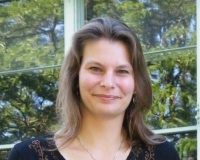Jane Daniels
Director of Preservation Programs at Colorado Preservation, Inc.

This profile was originally published in 2012 by Dr. Joy Adams
While growing up as a first-generation Czech American in a small community near Milwaukee, Jane Daniels developed a keen interest in her own heritage as well as the cultural backgrounds and customs of others. However, she didn’t consider heritage as a potential career path until she took a graduate course in historic preservation at The University of Wyoming while pursuing her master’s degree in international studies and environmental conservation. “I instantly saw the overlap between heritage and my undergraduate training in geography and environmental studies,” she says. “I saw it as an opportunity for doing something that was meaningful to me and that I had been trained in.”
Jane’s undergraduate education at The University of Wisconsin-Madison was excellent preparation for her position with Colorado Preservation, Inc., a private, nonprofit statewide historic preservation organization. “As geographers, we have a tendency to look at the world in a broad sense,” she explains. Preparing a proposal explaining why a site should be preserved and developing plans for how it should be interpreted require her to analyze a wide array of data. Jane needs to consider the site’s historical, cultural, political and economic contexts as well as material aspects of the surrounding landscape, such as transportation networks, zoning restrictions, and local architecture. She also needs to carefully evaluate the costs, benefits, opportunities, and limitations of each potential project. In her opinion, professionals with an interdisciplinary background that combines the liberal arts and the natural sciences are particularly well-equipped for this sort of work.
Jane’s position as Director of Preservation Programs encompasses a number of additional responsibilities, including developing funding strategies, financial reporting and budgeting, public relations, and hiring contractors. Cooperating with a broad, diverse group of stakeholders is a key skill, which requires well-developed abilities in oral communication, writing, and public speaking. Jane also got on-the-job training in several important areas that weren’t included in her university curricula, specifically real estate, financial management, and architecture and construction. She strongly recommends that aspiring preservationists seek hands-on experience in the field. Before joining Colorado Preservation, Inc., in 2008, Jane was the Executive Director of the Main Street Program in Laramie, Wyoming, and she previously worked in the private sector as a consultant to rural communities and in the public sector for the City of Madison.
Jane’s ideal job candidates also demonstrate consistency in their interestsand a commitment to pursuing them. On working in the nonprofit sector, she observes: “There’s an opportunity to become more personally invested in whatever work you’re doing. There’s a chance that you’ll fall in love with the buildings and projects you work with, so we tend to work very hard and become passionate.” Volunteer work provides evidence of one’s dedication to the cause as well as tangible experience in various aspects of historic preservation. “There are many opportunities to get involved without applying for a job outright,” Jane reports.
The current housing slump has slowed real estate markets, but this situation has opened doors for historic preservation. With new construction down, there is increased demand for the preservation and restoration of existing structures. Furthermore, growing interest in sustainable development, economic revitalization, and livable communities all have positive implications for the field, which is growing and gaining recognition. As historic properties are increasingly acknowledged as “worth preserving,” there is more room for people in the field who are specialists like Jane as well as for those who may not be experts just yet, but who can offer relevant knowledge and skills.